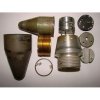tube8
Well-Known Member
Nice fuzes which are made post war.
One fuze(the dark one) is the Russian TM-30, the other both are made from CZ, model mczS30, one in aluminium, one in steal.
All fuzes come from offizeiel place where they was inert.
I think they all copy of the german S-30 time fuze from war time.
Or do the russian have this fuze also in war time?
One fuze(the dark one) is the Russian TM-30, the other both are made from CZ, model mczS30, one in aluminium, one in steal.
All fuzes come from offizeiel place where they was inert.
I think they all copy of the german S-30 time fuze from war time.
Or do the russian have this fuze also in war time?









